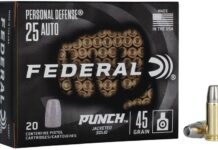It’s a trope seen in many a comedy sketch of an action movie or western. A round of ammunition literally “cooking” off. The bullet then comically cascades around the immediate environment wreaking havoc but generally only causing comical injuries and the most minor of damage as it pings off pots and pans and eventually boops someone in the buttocks.
Hilarious.
And like many a Hollywood firearm faux pas… Completely against the laws of physics. As Brandon demonstrates in the video, macro laws of physics are still in place when it comes to firearms. Firearms run on these laws. Everything we developed to make firearms run as they do is because of our understanding of physics, from simple leverage, to heat and pressure, to fluid dynamics and atmospherics.
Grade School Physics Lesson
The reason the bullet goes down the barrel as the gas from the burning powder expands is because, when it is encased in the steel of the chamber and bolt, the barrel is the path of least resistance. Pressure seeks and takes that path of least resistance.
In open air the path of least resistance isn’t defined by the steel walls of the chamber and bolt face. It is instead defined by the fact that the bullet is the heaviest and most dense piece, and thus an ‘anchor point’ and the ground or any solid surface the case might be resting against. Including the charcoal in this case which is also providing ignition heat instead of a direct spark. So the grain of powder that hits ignition temperature first will start the reaction little more chaotically than a primer.
All this to say that essentially you have a brass or steel bodied fire-cracker and not a device that will throw a bullet. The bullet is the mass keeping it in place most solidly in fact. It is the metallic case that makes the round a hazard still at close distance. The metal is being heated unevenly and is not supported so it is going to split, possibly fragment, and jump wherever it has the energy to get to with the escaping gas. Not at X,000 feet per second, but with enough spice to cause lacerations in soft exposed tissues. The eyeballs are probably at greatest risk of severe injury as they are a highly vulnerably piece of anatomy to any small flying bits.
All of these facets are why fireworks use paper and cardboard as their sealing systems in many cases, those do not turn into flying bits of metal which reduces the number of sources that can cause injury to just the burning compounds and the raw force of the detonation/gas expansion.
Dangerous?
“Risky” I think is the more accurate term. Dangerous implies an unacceptable under all circumstances level of risk, although not strictly meaning that. “Risky” implies a moderate level of risk where injury or damage could occur but can be easily mitigated or accepted as the situation may allow or dictate necessary. There is overlap and subjective personal biases and all that but all in all risk here is mitigated quite a bit by distance and effectively eliminated by an imposed barrier (hill)
Still. Cool physics. Despite the fact that at today’s rates Brandon burned about $55.76 (rounded up) in a fire for science.



